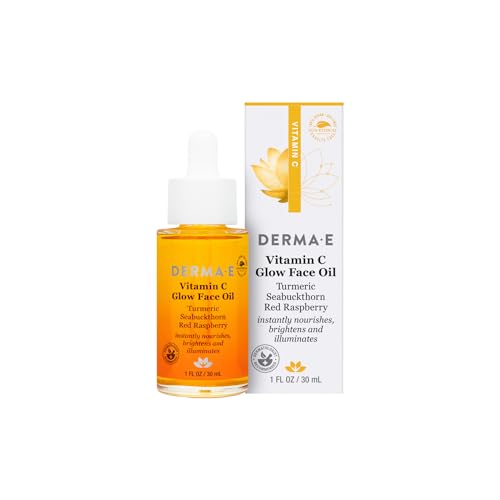
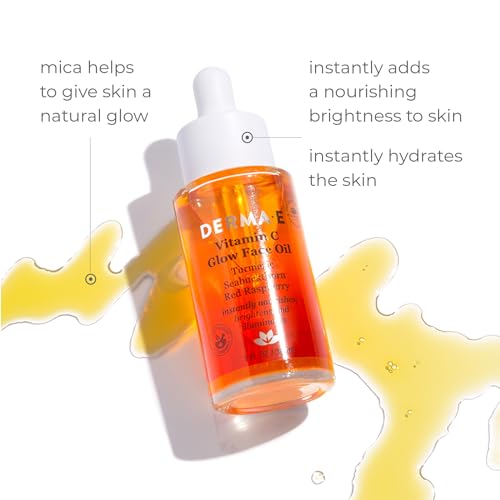
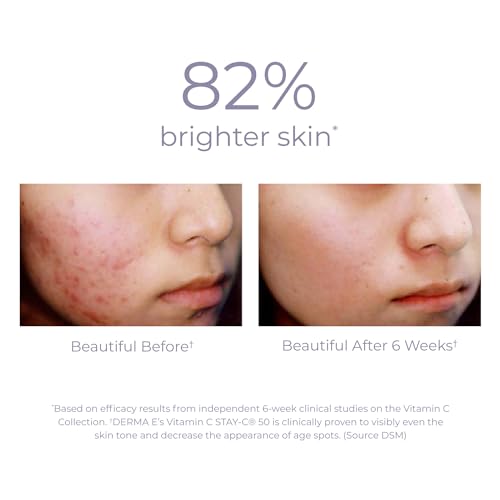
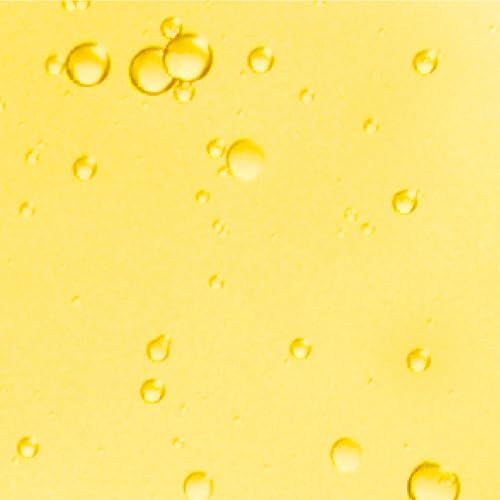
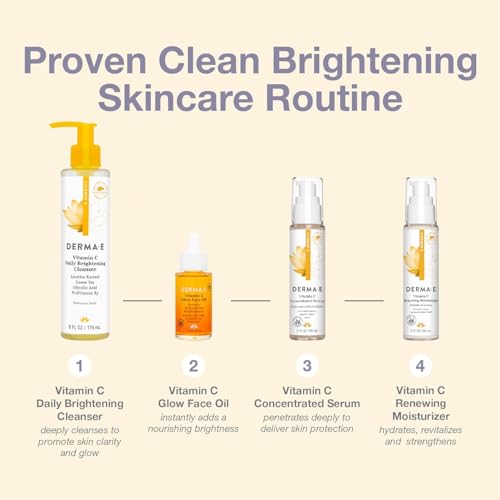
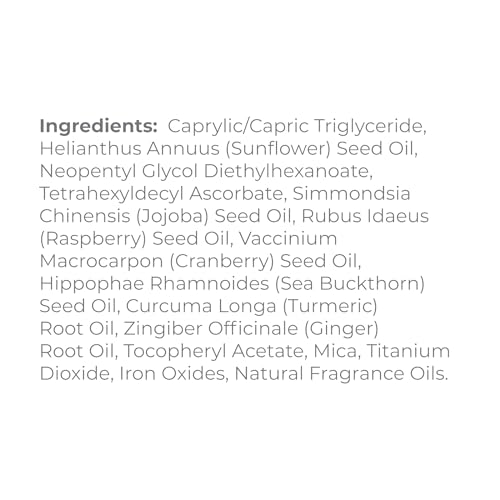
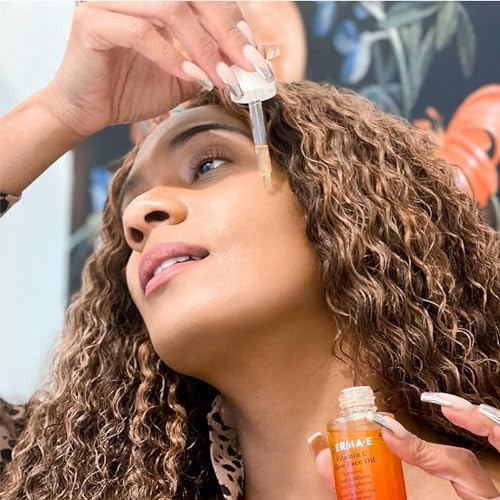
Derma E Vitamin C Glow Face Oil - Nourishes & Brightens for Radiant Skin - 1 Fl Oz


Fragrance
High RiskFragrance refers to a mixture of aromatic compounds used in products to provide scent. It is commonly listed as 'fragrance' or 'parfum' on product labels and can serve various functions, including enhancing user experience and masking undesirable odors.
Sustai Insights
Fragrance offers functional benefits by improving product appeal; however, it poses significant health risks, notably a high likelihood of causing allergies and allergic contact dermatitis. Environmental risks include potential pollution and endocrine disruption, though its overall carcinogenicity is low. Regulatory bodies have noted concerns regarding its use, leading to a high-risk classification. Safe usage practices should be observed, and alternatives such as natural essential oils are recommended for those sensitive to synthetic fragrances.
Titanium Dioxide
Medium RiskTitanium dioxide is an inorganic compound used primarily as a pigment due to its brightness and high refractive index. It is commonly found in products such as paints, coatings, plastics, and cosmetics, providing color and opacity.
Sustai Insights
Titanium dioxide serves effectively as a UV filter and colorant, enhancing product stability and performance. However, it has been classified as a moderate concern for potential carcinogenicity and carries low risks for allergies and reproductive toxicity. Environmental risks include its pollutant potential, though it is not known to bioaccumulate. Regulatory bodies have issued specific restrictions regarding its use, leading to an overall medium risk assessment. Safe usage practices should be observed, with consideration for alternatives such as zinc oxide for a more sustainable option.
Tocopheryl Acetate
Medium RiskTocopheryl acetate is a chemical compound that serves primarily as a form of Vitamin E. It is used in cosmetic and personal care products for its antioxidant properties and to enhance skin stability and moisture.
Sustai Insights
Tocopheryl acetate is valued for its functional benefits, including acting as an antioxidant and skin conditioning agent. It is generally considered to have low carcinogenicity and reproductive toxicity risk, although it poses a moderate concern for allergies. Environmental risks are minimal, with no significant pollutant or bioaccumulation potential noted. Regulatory bodies have not imposed significant restrictions. Safe usage practices should be followed, particularly regarding enhanced skin absorption. Alternatives like natural Vitamin E may provide similar benefits with potentially lower allergenic properties. Overall, this ingredient presents a medium risk assessment.
Mica
Low RiskMica is a type of highly brittle silicate mineral commonly used in cosmetics and personal care products for its reflective properties and texture. It serves primarily as a colorant and opacifying agent, enhancing the aesthetic appeal of formulations.
Sustai Insights
Mica provides functional benefits such as adding shimmer and improving the texture of cosmetics. It is generally considered low risk concerning health concerns like carcinogenicity and allergenic potential. However, there are risks associated with its persistence and potential for bioaccumulation in the environment. Regulatory bodies have noted some restrictions on mica sourcing due to ethical concerns surrounding mining practices. Overall, while mica has low health risks, its environmental impact necessitates careful sourcing and consideration of alternatives like synthetic colorants or other natural minerals.
Curcuma Longa (Turmeric) Oil
Low RiskCurcuma longa (turmeric) oil is derived from the turmeric plant, primarily known for its active compound, curcumin. It is commonly used in cosmetics and personal care products for its potential antioxidant and anti-inflammatory properties, contributing to skin health and overall product formulation.
Sustai Insights
Curcuma longa (turmeric) oil offers functional benefits as an antioxidant and anti-inflammatory agent, enhancing skin health in cosmetic formulations. It is sustainably sourced and biodegradable. Health risks are minimal, with low concerns for carcinogenicity, allergies, and reproductive toxicity. Environmental risks are also low, with no significant pollutant potential. Regulatory bodies do not list it as restricted. Overall, the risk level associated with this ingredient is low, making it a viable option in personal care products.
Tetrahexyldecyl Ascorbate
Low RiskTetrahexyldecyl ascorbate is an ester of hexyl ascorbic acid, a stable form of vitamin C, commonly used in cosmetic formulations for its antioxidant properties. It is employed to improve skin appearance, enhance radiance, and provide photoprotection.
Sustai Insights
Tetrahexyldecyl ascorbate offers functional benefits as an antioxidant, promoting skin health and appearance. It is generally regarded as safe, with low concerns for carcinogenicity, allergies, and irritation. Although it poses minimal environmental risks, regulatory bodies have outlined specific usage guidelines. Overall, its risk level is assessed as low, making it a viable option in cosmetic formulations.
Zingiber Officinale (Ginger) Root Oil
Low RiskZingiber officinale (ginger) root oil is obtained from the rhizome of the ginger plant. It is commonly used in various products for its aromatic properties and potential health benefits. The oil contains bioactive compounds that may contribute to its effectiveness in formulations.
Sustai Insights
Zingiber officinale (ginger) root oil serves as a natural fragrance and may provide anti-inflammatory benefits. It is sustainably sourced and considered biodegradable. Health risks are low, with minimal concerns regarding carcinogenicity, allergenicity, or reproductive toxicity. Environmental impact is negligible, and regulatory status is compliant with current guidelines. Overall, the ingredient presents a low risk profile, making it a suitable choice in formulations.
Hippophae Rhamnoides (Sea Buckthorn) Oil
Low RiskHippophae rhamnoides oil, commonly known as sea buckthorn oil, is a fixed oil extracted from the berries of the sea buckthorn plant. It is primarily used in cosmetic formulations for its moisturizing and skin-nourishing properties, often incorporated for its fatty acid profile and antioxidant content.
Sustai Insights
Hippophae rhamnoides oil offers functional benefits such as skin hydration and potential antioxidant effects, contributing to improved skin health. It is sustainably sourced and biodegradable. The ingredient is associated with low health risks, including minimal concerns for carcinogenicity, allergies, and reproductive toxicity. Environmental risks are also low, with no significant pollutant or bioaccumulation potential identified. Regulatory status indicates no severe restrictions. Overall, this ingredient is assessed as low risk and safe for use in cosmetic products, with no specific safer alternatives readily available.
Rubus Idaeus (Raspberry) Seed Oil
Low RiskRubus idaeus (raspberry) seed oil is a fixed oil extracted from the seeds of the raspberry fruit. It is primarily used in cosmetic formulations for its emollient properties, helping to moisturize and soften the skin while providing a unique fatty acid profile.
Sustai Insights
Rubus idaeus (raspberry) seed oil offers functional benefits as a moisturizer and is sustainably sourced, contributing to eco-friendly formulations. Health risks are minimal, with low concerns regarding carcinogenicity, allergenic potential, and reproductive toxicity. Environmentally, it poses low pollutant risks and is not bioaccumulative. Regulatory agencies do not impose significant restrictions. Overall, the risk level is low, making it a safe choice in cosmetic products.
Neopentyl Glycol Diethylhexanoate
Low RiskNeopentyl glycol diethylhexanoate is a diester formed from neopentyl glycol and diethylhexanoic acid, commonly used in cosmetic formulations as an emollient. It enhances skin feel and provides moisture retention, contributing to the overall texture and stability of products.
Sustai Insights
Neopentyl glycol diethylhexanoate exhibits functional benefits as an effective emollient, improving skin texture and moisture retention. Health risks are considered low, with no significant concerns regarding carcinogenicity, allergies, or reproductive toxicity. Environmentally, it poses low risks, with no evidence of bioaccumulation or significant pollution. Regulatory bodies have not imposed restrictions on its use. Overall, the ingredient is assessed to have a low risk profile, suitable for use in cosmetic products.
Vaccinium Macrocarpon (Cranberry) Seed Oil
Low RiskVaccinium macrocarpon (cranberry) seed oil is derived from the seeds of the cranberry plant. It is commonly used in cosmetic formulations for its emollient properties, providing moisture and improving skin texture. The oil is rich in fatty acids and antioxidants, contributing to its popularity in skin care products.
Sustai Insights
Vaccinium macrocarpon (cranberry) seed oil offers functional benefits as a moisturizer and skin conditioner, contributing to product efficacy. It is sustainably sourced, with minimal environmental risks identified, resulting in a low overall risk level. Health concerns such as carcinogenicity, allergies, and reproductive toxicity are low, and there are no significant regulatory restrictions. Safe usage practices include ensuring proper formulation concentrations, with alternatives like jojoba oil available for similar benefits. Overall, the ingredient is considered low risk.
Ci 77499
Low RiskCI 77499, also known as iron oxides, are inorganic pigments commonly used in cosmetic products for their coloring properties. They provide a range of shades and are often included for their stability and opacity, enhancing the visual appeal of formulations.
Sustai Insights
CI 77499 offers functional benefits as a stable colorant, contributing to product aesthetics without significant health risks, as concerns for carcinogenicity, allergies, and reproductive toxicity are low. However, it has high persistence and bioaccumulation potential in the environment, raising ecotoxicity concerns. Regulatory restrictions exist for certain uses. Overall, the ingredient presents a low risk profile when used according to safety guidelines, with alternatives available for those seeking greener options.
Caprylic/Capric Triglyceride
Low RiskCaprylic/capric triglyceride is a mixed triester derived from coconut oil and glycerin, primarily used as an emollient and skin-conditioning agent in cosmetic formulations. It serves to improve the texture and spreadability of products while providing a lightweight, non-greasy feel on the skin.
Sustai Insights
Caprylic/capric triglyceride offers functional benefits as an effective emollient, enhancing skin hydration without clogging pores. It is biodegradable, contributing to sustainability. Health risks are low, with minimal concerns regarding carcinogenicity, allergies, or reproductive toxicity. Environmental impacts are also low, with no known pollutant status. Regulatory assessments indicate no current restrictions. Overall, this ingredient presents a low risk profile, making it a safe choice in cosmetic applications.
Helianthus Annuus (Sunflower) Seed Oil
Low RiskHelianthus annuus (sunflower) seed oil is derived from the seeds of the sunflower plant. It serves primarily as an emollient and moisturizer in cosmetic formulations, helping to maintain skin hydration and improve texture.
Sustai Insights
Sunflower seed oil is effective as an emollient, providing moisture and improving skin texture while being biodegradable and sustainably sourced. It poses low health risks, including negligible concerns for carcinogenicity, allergies, or reproductive toxicity. Environmentally, it does not significantly contribute to pollution or bioaccumulation. Regulatory bodies currently do not list any advisories for this ingredient. Overall, it is assessed as low risk, with safe usage practices recommended. Alternatives include oils like jojoba or almond oil for those seeking different properties.
Simmondsia Chinensis (Jojoba) Seed Oil
Low RiskSimmondsia chinensis (jojoba) seed oil is extracted from the seeds of the jojoba plant. It is commonly used in cosmetics for its moisturizing properties and ability to mimic human sebum, making it beneficial for skin and hair care formulations.
Sustai Insights
Jojoba seed oil offers functional benefits such as effective moisturization and emollience, contributing to skin hydration and smoothness. It is sustainably sourced and biodegradable. Health risks are low, with minimal concerns regarding carcinogenicity, allergies, and reproductive toxicity. Environmental risks are also low, as it does not significantly contribute to pollution or bioaccumulation. Currently, there are no regulatory restrictions on its use. Overall, the risk level is low, and it is considered a safe ingredient with no significant adverse effects.
Mica
Low RiskMica is a type of highly brittle silicate mineral commonly used in cosmetics and personal care products for its reflective properties and texture. It serves primarily as a colorant and opacifying agent, enhancing the aesthetic appeal of formulations.
Sustai Insights
Mica provides functional benefits such as adding shimmer and improving the texture of cosmetics. It is generally considered low risk concerning health concerns like carcinogenicity and allergenic potential. However, there are risks associated with its persistence and potential for bioaccumulation in the environment. Regulatory bodies have noted some restrictions on mica sourcing due to ethical concerns surrounding mining practices. Overall, while mica has low health risks, its environmental impact necessitates careful sourcing and consideration of alternatives like synthetic colorants or other natural minerals.
Curcuma Longa (Turmeric) Oil
Low RiskCurcuma longa (turmeric) oil is derived from the turmeric plant, primarily known for its active compound, curcumin. It is commonly used in cosmetics and personal care products for its potential antioxidant and anti-inflammatory properties, contributing to skin health and overall product formulation.
Sustai Insights
Curcuma longa (turmeric) oil offers functional benefits as an antioxidant and anti-inflammatory agent, enhancing skin health in cosmetic formulations. It is sustainably sourced and biodegradable. Health risks are minimal, with low concerns for carcinogenicity, allergies, and reproductive toxicity. Environmental risks are also low, with no significant pollutant potential. Regulatory bodies do not list it as restricted. Overall, the risk level associated with this ingredient is low, making it a viable option in personal care products.
Tetrahexyldecyl Ascorbate
Low RiskTetrahexyldecyl ascorbate is an ester of hexyl ascorbic acid, a stable form of vitamin C, commonly used in cosmetic formulations for its antioxidant properties. It is employed to improve skin appearance, enhance radiance, and provide photoprotection.
Sustai Insights
Tetrahexyldecyl ascorbate offers functional benefits as an antioxidant, promoting skin health and appearance. It is generally regarded as safe, with low concerns for carcinogenicity, allergies, and irritation. Although it poses minimal environmental risks, regulatory bodies have outlined specific usage guidelines. Overall, its risk level is assessed as low, making it a viable option in cosmetic formulations.
Zingiber Officinale (Ginger) Root Oil
Low RiskZingiber officinale (ginger) root oil is obtained from the rhizome of the ginger plant. It is commonly used in various products for its aromatic properties and potential health benefits. The oil contains bioactive compounds that may contribute to its effectiveness in formulations.
Sustai Insights
Zingiber officinale (ginger) root oil serves as a natural fragrance and may provide anti-inflammatory benefits. It is sustainably sourced and considered biodegradable. Health risks are low, with minimal concerns regarding carcinogenicity, allergenicity, or reproductive toxicity. Environmental impact is negligible, and regulatory status is compliant with current guidelines. Overall, the ingredient presents a low risk profile, making it a suitable choice in formulations.
Hippophae Rhamnoides (Sea Buckthorn) Oil
Low RiskHippophae rhamnoides oil, commonly known as sea buckthorn oil, is a fixed oil extracted from the berries of the sea buckthorn plant. It is primarily used in cosmetic formulations for its moisturizing and skin-nourishing properties, often incorporated for its fatty acid profile and antioxidant content.
Sustai Insights
Hippophae rhamnoides oil offers functional benefits such as skin hydration and potential antioxidant effects, contributing to improved skin health. It is sustainably sourced and biodegradable. The ingredient is associated with low health risks, including minimal concerns for carcinogenicity, allergies, and reproductive toxicity. Environmental risks are also low, with no significant pollutant or bioaccumulation potential identified. Regulatory status indicates no severe restrictions. Overall, this ingredient is assessed as low risk and safe for use in cosmetic products, with no specific safer alternatives readily available.
Rubus Idaeus (Raspberry) Seed Oil
Low RiskRubus idaeus (raspberry) seed oil is a fixed oil extracted from the seeds of the raspberry fruit. It is primarily used in cosmetic formulations for its emollient properties, helping to moisturize and soften the skin while providing a unique fatty acid profile.
Sustai Insights
Rubus idaeus (raspberry) seed oil offers functional benefits as a moisturizer and is sustainably sourced, contributing to eco-friendly formulations. Health risks are minimal, with low concerns regarding carcinogenicity, allergenic potential, and reproductive toxicity. Environmentally, it poses low pollutant risks and is not bioaccumulative. Regulatory agencies do not impose significant restrictions. Overall, the risk level is low, making it a safe choice in cosmetic products.
Neopentyl Glycol Diethylhexanoate
Low RiskNeopentyl glycol diethylhexanoate is a diester formed from neopentyl glycol and diethylhexanoic acid, commonly used in cosmetic formulations as an emollient. It enhances skin feel and provides moisture retention, contributing to the overall texture and stability of products.
Sustai Insights
Neopentyl glycol diethylhexanoate exhibits functional benefits as an effective emollient, improving skin texture and moisture retention. Health risks are considered low, with no significant concerns regarding carcinogenicity, allergies, or reproductive toxicity. Environmentally, it poses low risks, with no evidence of bioaccumulation or significant pollution. Regulatory bodies have not imposed restrictions on its use. Overall, the ingredient is assessed to have a low risk profile, suitable for use in cosmetic products.
Vaccinium Macrocarpon (Cranberry) Seed Oil
Low RiskVaccinium macrocarpon (cranberry) seed oil is derived from the seeds of the cranberry plant. It is commonly used in cosmetic formulations for its emollient properties, providing moisture and improving skin texture. The oil is rich in fatty acids and antioxidants, contributing to its popularity in skin care products.
Sustai Insights
Vaccinium macrocarpon (cranberry) seed oil offers functional benefits as a moisturizer and skin conditioner, contributing to product efficacy. It is sustainably sourced, with minimal environmental risks identified, resulting in a low overall risk level. Health concerns such as carcinogenicity, allergies, and reproductive toxicity are low, and there are no significant regulatory restrictions. Safe usage practices include ensuring proper formulation concentrations, with alternatives like jojoba oil available for similar benefits. Overall, the ingredient is considered low risk.
Ci 77499
Low RiskCI 77499, also known as iron oxides, are inorganic pigments commonly used in cosmetic products for their coloring properties. They provide a range of shades and are often included for their stability and opacity, enhancing the visual appeal of formulations.
Sustai Insights
CI 77499 offers functional benefits as a stable colorant, contributing to product aesthetics without significant health risks, as concerns for carcinogenicity, allergies, and reproductive toxicity are low. However, it has high persistence and bioaccumulation potential in the environment, raising ecotoxicity concerns. Regulatory restrictions exist for certain uses. Overall, the ingredient presents a low risk profile when used according to safety guidelines, with alternatives available for those seeking greener options.
Fragrance
High RiskFragrance refers to a mixture of aromatic compounds used in products to provide scent. It is commonly listed as 'fragrance' or 'parfum' on product labels and can serve various functions, including enhancing user experience and masking undesirable odors.
Sustai Insights
Fragrance offers functional benefits by improving product appeal; however, it poses significant health risks, notably a high likelihood of causing allergies and allergic contact dermatitis. Environmental risks include potential pollution and endocrine disruption, though its overall carcinogenicity is low. Regulatory bodies have noted concerns regarding its use, leading to a high-risk classification. Safe usage practices should be observed, and alternatives such as natural essential oils are recommended for those sensitive to synthetic fragrances.
Titanium Dioxide
Medium RiskTitanium dioxide is an inorganic compound used primarily as a pigment due to its brightness and high refractive index. It is commonly found in products such as paints, coatings, plastics, and cosmetics, providing color and opacity.
Sustai Insights
Titanium dioxide serves effectively as a UV filter and colorant, enhancing product stability and performance. However, it has been classified as a moderate concern for potential carcinogenicity and carries low risks for allergies and reproductive toxicity. Environmental risks include its pollutant potential, though it is not known to bioaccumulate. Regulatory bodies have issued specific restrictions regarding its use, leading to an overall medium risk assessment. Safe usage practices should be observed, with consideration for alternatives such as zinc oxide for a more sustainable option.
Tocopheryl Acetate
Medium RiskTocopheryl acetate is a chemical compound that serves primarily as a form of Vitamin E. It is used in cosmetic and personal care products for its antioxidant properties and to enhance skin stability and moisture.
Sustai Insights
Tocopheryl acetate is valued for its functional benefits, including acting as an antioxidant and skin conditioning agent. It is generally considered to have low carcinogenicity and reproductive toxicity risk, although it poses a moderate concern for allergies. Environmental risks are minimal, with no significant pollutant or bioaccumulation potential noted. Regulatory bodies have not imposed significant restrictions. Safe usage practices should be followed, particularly regarding enhanced skin absorption. Alternatives like natural Vitamin E may provide similar benefits with potentially lower allergenic properties. Overall, this ingredient presents a medium risk assessment.
Caprylic/Capric Triglyceride
Low RiskCaprylic/capric triglyceride is a mixed triester derived from coconut oil and glycerin, primarily used as an emollient and skin-conditioning agent in cosmetic formulations. It serves to improve the texture and spreadability of products while providing a lightweight, non-greasy feel on the skin.
Sustai Insights
Caprylic/capric triglyceride offers functional benefits as an effective emollient, enhancing skin hydration without clogging pores. It is biodegradable, contributing to sustainability. Health risks are low, with minimal concerns regarding carcinogenicity, allergies, or reproductive toxicity. Environmental impacts are also low, with no known pollutant status. Regulatory assessments indicate no current restrictions. Overall, this ingredient presents a low risk profile, making it a safe choice in cosmetic applications.
Helianthus Annuus (Sunflower) Seed Oil
Low RiskHelianthus annuus (sunflower) seed oil is derived from the seeds of the sunflower plant. It serves primarily as an emollient and moisturizer in cosmetic formulations, helping to maintain skin hydration and improve texture.
Sustai Insights
Sunflower seed oil is effective as an emollient, providing moisture and improving skin texture while being biodegradable and sustainably sourced. It poses low health risks, including negligible concerns for carcinogenicity, allergies, or reproductive toxicity. Environmentally, it does not significantly contribute to pollution or bioaccumulation. Regulatory bodies currently do not list any advisories for this ingredient. Overall, it is assessed as low risk, with safe usage practices recommended. Alternatives include oils like jojoba or almond oil for those seeking different properties.
Simmondsia Chinensis (Jojoba) Seed Oil
Low RiskSimmondsia chinensis (jojoba) seed oil is extracted from the seeds of the jojoba plant. It is commonly used in cosmetics for its moisturizing properties and ability to mimic human sebum, making it beneficial for skin and hair care formulations.
Sustai Insights
Jojoba seed oil offers functional benefits such as effective moisturization and emollience, contributing to skin hydration and smoothness. It is sustainably sourced and biodegradable. Health risks are low, with minimal concerns regarding carcinogenicity, allergies, and reproductive toxicity. Environmental risks are also low, as it does not significantly contribute to pollution or bioaccumulation. Currently, there are no regulatory restrictions on its use. Overall, the risk level is low, and it is considered a safe ingredient with no significant adverse effects.
Discover the Derma E Vitamin C Glow Face Oil, a nourishing blend designed to illuminate and hydrate your skin. Infused with powerful natural ingredients like Turmeric, Seabuckthorn, and Red Raspberry, this facial oil delivers a radiant glow without greasiness, making it suitable for all skin types.
- Nourishing Brightness: Enriched with Vitamin C, this oil revitalizes your complexion, leaving skin soft and supple.
- Deep Hydration: Formulated to deeply moisturize and renew, it promotes a plump, smooth appearance while ensuring a touchable finish.
- Natural Ingredients: Made with a unique blend of Turmeric, Seabuckthorn Oil, and Red Raspberry for enhanced skin health and nourishment.
- Daily Use: Easy to incorporate into your skincare routine, simply massage a few drops onto clean skin for best results.
- Eco-Friendly Commitment: Vegan and cruelty-free, Derma E products are free from over 2,500 harmful ingredients and come in recyclable packaging, supporting a healthier planet.
Embrace a cleaner, more radiant you with this effective and responsible skincare solution.
Subscribe & Save with Sustai
- Best Price Guarantee: Always enjoy the lowest prices on sustainable home essentials.
- No Surprises: We’ll notify you before shipping. No hidden fees, ever.
- You’re in Charge: Change, pause, or cancel your subscription anytime with ease.
- Eco-Friendly Deliveries: Our grouped shipments mean less packaging and lower emissions.
Join us on a sustainable journey. Special offers for a limited time! Prices and promotions may change.
Recommended Products
Discover the Derma E Vitamin C Glow Face Oil, a nourishing blend designed to illuminate and hydrate your skin. Infused with powerful natural ingredients like Turmeric, Seabuckthorn, and Red Raspberry, this facial oil delivers a radiant glow without greasiness, making it suitable for all skin types.
- Nourishing Brightness: Enriched with Vitamin C, this oil revitalizes your complexion, leaving skin soft and supple.
- Deep Hydration: Formulated to deeply moisturize and renew, it promotes a plump, smooth appearance while ensuring a touchable finish.
- Natural Ingredients: Made with a unique blend of Turmeric, Seabuckthorn Oil, and Red Raspberry for enhanced skin health and nourishment.
- Daily Use: Easy to incorporate into your skincare routine, simply massage a few drops onto clean skin for best results.
- Eco-Friendly Commitment: Vegan and cruelty-free, Derma E products are free from over 2,500 harmful ingredients and come in recyclable packaging, supporting a healthier planet.
Embrace a cleaner, more radiant you with this effective and responsible skincare solution.

You can have at most 2 Sustainable Steals products in your cart
Customer Reviews
Customers’ View
Customers appreciate the effectiveness and nourishing properties of the Facial Oil, highlighting its ability to enhance skin brightness and provide a healthy glow. Many users note that the combination of Vitamin C and Turmeric transforms dull skin into a radiant complexion, with some mentioning its lightweight texture that absorbs quickly without an oily residue. The pleasant scent is also frequently praised, contributing to a refreshing application experience. Furthermore, customers value the product's affordability, recognizing it as a cost-effective alternative to more expensive serums, especially given its moisturizing benefits. With a commitment to eco-friendly practices, including vegan and cruelty-free formulations, this product aligns well with the values of health-conscious consumers. Overall, customers find this facial oil effective and in harmony with their sustainable lifestyle.
AI-generated from the text of customer reviewsThis product has no reviews yet.




